|
|
|
|
|

PHOENIX
Origin = China
Chn. = Fèng Huáng, Feng Huang 鳳凰
Jp. = Hō-ō 鳳凰 or Hou-ou, Ho-o, Hoo-oo
Feng 鳳 represents male phoenix, yang, solar
Huang 凰 represents female phoenix, yin, lunar
Often depicted together with the Dragon,
either as mortal enemies or as blissful lovers.
One of Four Celestial Guardians of Four Directions
Considered equivalent to the Red Bird | Big Bird
|
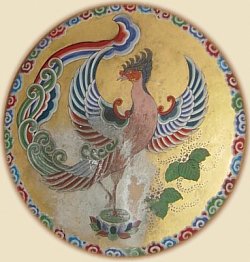
Phoenix Drum, Engaku-ji Temple 円覚寺
Located in the Bell Tower, Kita-Kamakura
|
|

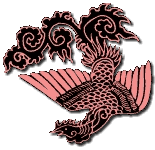 In Japan, as earlier in China, the mythical Phoenix was adopted as a symbol of the imperial household, particularily the empress. This mythical bird represents fire, the sun, justice, obedience, fidelity, and the southern star constellations. In Japan, as earlier in China, the mythical Phoenix was adopted as a symbol of the imperial household, particularily the empress. This mythical bird represents fire, the sun, justice, obedience, fidelity, and the southern star constellations.
According to legend (mostly from China), the Hō-ō appears very rarely, and only to mark the beginning of a new era -- the birth of a virtuous ruler, for example. In other traditions, the Hō-ō appears only in peaceful and prosperous times (nesting, it is said, in paulownia trees), and hides itself when there is trouble. As the herald of a new age, the Hō-ō decends from heaven to earth to do good deeds, and then it returns to its celestial abode to await a new era. It is both a symbol of peace (when the bird appears) and a symbol of disharmony (when the bird disappears). In China, early artifacts show the Phoenix (female) as intimately associated with the Dragon (male) -- the two are portrayed either as mortal enemies or as blissful lovers. When shown together, the two symbolize both conflict and wedded bliss, and are a common design motif even today in many parts of Asia (see below).
鳳 = Fèng, Male Phoenix 凰 = Huáng, Female Phoenix
The Chinese compound term Fèng Huáng means Phoenix. The Feng Huang was believed to control the five tones of traditional Chinese music and to represent the Confucian virtues of loyalty, honesty, decorum and justice. Its image first appears on Shang artifacts of China’s Western Zhou Period (11th century BC to 771 BC).
The symbolism of the Chinese Phoenix (Fèng Huáng) is strikingly similar to the symbolism of the mythological Red Bird (Chn. = Zhū Qiǎo 朱雀 or Zhū Niǎo 朱鳥), also of Chinese lore. In Japan, the Red Bird is pronounced Suzaku (same Chinese characters). I believe the Red Bird is the same creature as the Phoenix, although I may be wrong. The Red Bird is one of four legendary Chinese creatures guarding the four cosmic directions (Red Bird - S, Dragon - E, Tortoise - N, and the Tiger - W). The four appear during China’s Warring States period (476 BC - 221 BC), and were frequently painted on the walls of early Chinese and Korean tombs to ward off evil spirits. For more details on Phoenix lore in China, please click here.
The Asian Phoenix should not be confused with the Phoenix found in Egypt and Greece -- that is a bird of completely different feathers and traditions. The Arabian-Western Phoenix, if you recall, is a solidary creature -- only one of its kind. When it dies, it dies in flames, and from the ashes is born the next phoenix. Click here for background on the Egyptian and Greek phoenix.

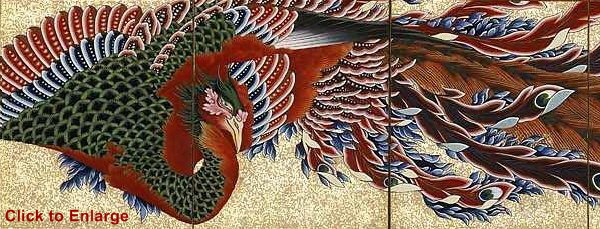

8-Panel Phoenix Screen (Hō-ō zu Byōbu) by Katsushika Hokusai 葛飾北斎 (1760-1849)
Photo: www.mfa.org/collections/search_art.asp?recview=true&id=26334
One of the most widely know depictions of the Phoenix in the West.
By Japanese artist Katsushika Hokusai 葛飾北斎 (1760-1849).
Painted on a Byōbu 屏風 (folding screen). Museum of Fine Arts, Boston.
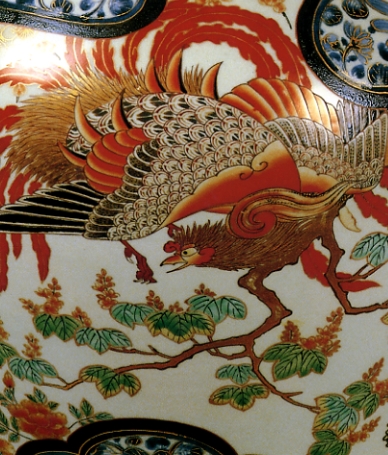
Phoenix, Image from Imari Porcelain ware
Photo courtesy Nihon Toji Taikei magazine, Vol. 19 (Imari Ware)

Phoenix Panel by Takamura Kōun 高村光雲 (1852-1934)
Carved wooden Phoenix transom panels (ranma 欄間) from the Phoenix Hall (Hō-ō-den 鳳凰殿), the Japanese
Pavilion at the World's Columbian Exposition, 1893. Gift of the Chicago Park District. Carved by Takamura Kōun.
Photo courtesy of The Art Institute of Chicago. For more details, see
1893 expo's historic Japanese Phoenix panels reunited, restored (The SouthtownStar)

HISTORICAL NOTES ON THE PHOENIX IN JAPAN
Below text courtesy JAANUS: A mythical Chinese bird, thought to have been introduced to Japan in the Asuka period (mid 6th to mid 7th century AD). The phoenix has a bird's beak, a swallow's jaw, and a snake's neck; the front half of its body is thought to resemble a giraffe, the back half a deer. Its back resembles a tortoise, and its tail is like a fish. It is often shown in a paulownia tree (Chinese parasol tree, Jp. = Aogiri 梧桐), with bamboo in the background, or surrounded by Chinese arabesque foliage (Jp. = Karakusa 唐草). It became a popular decorative motif in the Nara period (late 7-8c), and was used on a wide variety of items including textiles, mirrors, chests, and lacquerware. Outstanding early examples of phoenix designs can be seen on the ceiling of Hōryūji Kondō Nishi-no-ma 法隆寺金堂西の間 (late 7c). Hō-ō depicted on the back of mirrors were popular in the Heian period (9-12c). Some of these used a Chinese style, but others Japanized the Hō-ō motif, replacing arabesque foliage with Japanese wild grasses, and changing the bird to resemble a blue magpie (Jp. = Onagadori 尾長鳥), or a crane (Jp. = Tsuru 鶴). A famous pair of Hō-ō statues, made of copper and measuring one metre in height, can be seen on the roof of Byōdō-in Hō-ō-do (photo here) 平等院鳳凰堂 , Kyoto (10c). Throughout the 13-19c the Hō-ō remained a popular design, particularly on gold and silver lacquered boxes (Jp. = Makie 蒔絵) and for Noh 能 costumes. The original Chinese background of paulownia and bamboo was gradually replaced by combinations of peonies, cherry blossoms, crysanthemums, and seasonal Japanese wild flowers. The phoenix appears on three crests (Jp. = Monshou 紋章), known as hō-ō-maru 鳳凰円, lit. phoenix circle, tachi hō-ō 立ち鳳凰 lit. standing phoenix, and tobi hō-ō 飛び鳳凰 lit. flying phoenix. <end quote JAANUS>
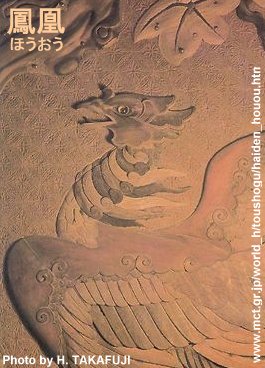
Phoenix, Wood
Carved on entrance to the Haiden (worship hall), Nikko Tōshogu Shrine (Tochigi Pref.)
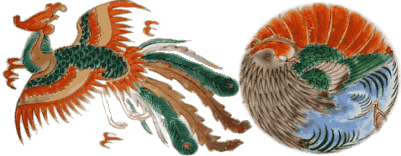
Above: Design on Edo-Period bowl
(at the online store of blueandwhiteamerica.com)
The phoenix is typically shown with spread wings,
in the act of attacking “naga” with its strong claws.
Skt. “NAGA” means all serpentines, snakes, and dragons.
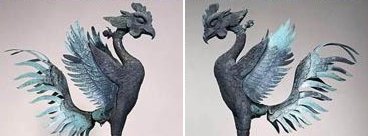
Above & Below
Heian Era, 11c, Atop Amida Hall, Byōdō-in, Kyoto
From early times (by at least China’s Han Period),
the Hō-ō was depicted as a male-female pair facing each other.
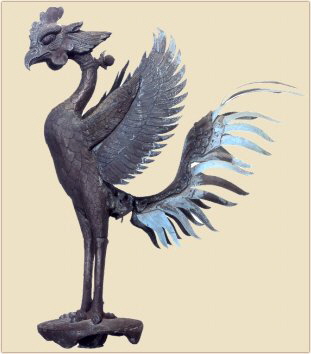

In China, the phoenix is ofter paired with the dragon
as well -- the pair represent both conflict and wedded bliss.
Above Photo: Hall of Heavenly and Terrestrial Union (China)
Ornamental door design of Phoenix (Empress) and Dragon (Emperor)
Courtesy www.kiku.com/electric_samurai/virtual_china/beijing.html

RED BIRD’S 28 Moon Lodges, 28 Lunar Mansions
An ancient astrological grouping from India and China that refers to 27 or 28 points that the moon passes through in one month and the associated star constellations found in the cosmic background. Each of these points (constellations) is associated with a deity. The 28 are divided into four clusters, with each cluster made up of seven constellations. The four clusters represent the four cardinal directions (north, south, east, west). Each cluster is associated with one of Four Celestial Emblems (turtle, red bird, dragon, white tiger), a Buddhist guardian deity (the Four Heavenly Kings), a season, a color, and numerous other attributes. See 28 Moon Lodges page for full details.
|
SOUTH
Seven Lunar Mansions of the Red Bird
(Two Common Japanese Groupings for Seven Southern Moon Lodges)
|
|

SUZAKU 朱雀 (Red Bird)
South, Red
Summer, Fire
|
  
|
|
GROUPING ONE - CHINA, JAPAN
Southern Moon Lodges
Japanese Reading | Chinese | Sanskrit
Source: Shukuyō-kyō 宿曜経
|
GROUPING TWO - JAPAN
Deities in GENZU MANDALA 現図曼荼羅
Shingon/Tendai Deities (Celestial Females)
Jp. Reading | Chinese | (Sanskrit) | Deity Name
|
|
1
|
Seishuku 井宿 Punarvasu
|
1
|
Seishuku 星宿 (Magha) 摩伽天
|
|
2
|
Kishuku 鬼宿 Tiṣya (or Puṣya)
|
2
|
Chōshuku 張宿 (Purva-phalguni) 間錯天
|
|
3
|
Ryūshuku 柳宿 Aśleṣā
|
3
|
Yokushuku 翼宿 (Uttara-phalguni) 果徳天
|
|
4
|
Seishuku 星宿 Maghā
|
4
|
Shinshuku 軫宿 (Hasta) 阿悉多天
|
|
5
|
Chōshuku 張宿 Pūrva-Phalgunī
|
5
|
Kakushuku 角宿 (Citra) 質多羅天
|
|
6
|
Yokushuku 翼宿 Uttara-Phalgunī
|
6
|
Kōhuku 亢宿 (Svati) 自記天
|
|
7
|
Shinshuku 軫宿 Hastā
|
7
|
Teishuku てい宿 (Visakha) 尾捨「イ+去」天
|
|
RED BIRD’S BUDDHIST COUNTERPARTS = PHOENIX 鳳凰 & ZŌCHŌTEN 増長天
Star Chart by Steve Renshaw & Saori Ihara
KEY TO BELOW LIST (corresponds to left column above)
Chinese | Meaning | Jp. Star Reading | Sanskrit Spelling | (Western Constellation)
1. 井, Well, Chichiri Boshi, Punarvasu (Mu Gem, Gemini)
2. 鬼, Ogre/Demon, Tamahome Boshi, Tiṣya/Puṣya (Delta Cnc, Theta Cnc, Cancer)
3. 柳, Willow, Nuriko Boshi, Aśleṣā (Delta Hya, Hydra)
4. 星, Star, Hotohori Boshi, Maghā (Alpha Hya, Alphard)
5. 張, Stretched Net, Chiriko Boshi, Pūrva-Phalgunī (Nu Hya, Crater)
6. 翼, Wings, Tasuki Boshi, Uttara-Phalgunī (Alpha Crt, Corvus)
7. 軫, Chariot Cross-Board, Mitsukake Boshi, Hastā (Gamma Crv, Corvus)
|
|

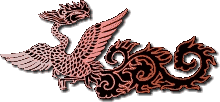 CHINESE LORE CHINESE LORE
Source: tina.garnet.nu/eiko/misc/eidolons2.htm
Feng, the Chinese phoenix, had the head of a pheasant, the tail of a peacock, the Five Cardinal Virtues inscribed on its body, and the most enchanting song of any bird. Feng was associated with the primordial forces of the heavens and was also the bringer of good fortunes, and visions of the phoenix god were were omens of great luck in the near future. Long (Dragon, East, Water) and Feng (Phoenix, South, Fire) are most often depicted as enemies because of their opposing elements (water and fire). Several Chinese folk tales center around the clash between the phoenix and the dragon. However, they're also depicted as partners. Long is the male counterpart to the female Feng, and together they can symbolize both conflict and wedded bliss.
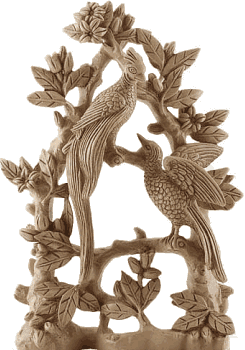 SOUTH - THE RED BIRD SOUTH - THE RED BIRD
Below exerpts from Derek Walters "An Encyclopedia of Myth and Legend: Chinese Mythology" and from Donald A. Mackenzie "Myths of China and Japan."
Writes Mackenzie: “Phoenix is used as a translation for Feng, or Feng Huang, the sacred bird of Chinese mythology. It has many miraculous attributes, but not self-rejuvenation, and does not possess the Arabian phoenix's propensity for self-immolation. It is usually portrayed as a beautiful bird, virtually identical to an ornamental pheasant. Few illustrations match its verbal description, as it is said to have the front of a swan, the hinder parts of a unicorn, the throat of a swallow, the bill of a chicken, the neck of a snake, the stripes of a dragon, and the arched back of a tortoise.
Its plumage is of the five mystical colours - black, white, red, green and yellow, and it has twelve tail feathers, execept in years when there is an extra month, when there are thirteen. It feeds on bamboo seeds, lives in the branches of the dryandera tree, and drinks from fountains of fresh water.
Writes Walters: “The phoenix is one of the four emblems of royalty, usually associated with the Empress. The expression “Dragon and Phoenix” signifies wedded bliss. In many respects its symbolism has been confused and merged with that of the Red Bird, one of the four Celestial Emblems."

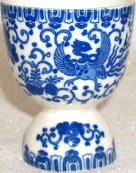 PHOENIX HISTORY, CHINA PHOENIX HISTORY, CHINA
Below text courtesy fenice.com/phoenix.html.
If we look at the Shang ritual cups and bronze decorations of the Western Zou period (around 3,000 years old) we find the images of five animals often repeated: the lion, the fish, the deer, the dragon and the phoenix.
The lion and the fish have origins in Buddhist icons, while the other three are often found together, such as on the inside of the coffin of the wife of the Marquis of Dai (2,200 years old). The four animals dragon, tiger, unicorn (or deer) and phoenix are called ”si ling” in Chinese, and with the passage of time other animals such as the snake and the tortoise were added to this group of animals to be worshipped.
Right from the earliest representations the phoenix has been shown with spread wings, often in the act of attacking snakes with its strong claws. During the Han period, 2,200 years ago, the Phoenix was used as a symbol to indicate the direction south, and was often shown in a pair of facing male and female birds. It may also be found paired with the dragon, in which case the dragon represents the Emperor and the phoenix the Empress.
An interesting difference between the way the dragon and the phoenix are shown in decorations is that the dragon is used to fill all the space available on a vase for example, while the phoenix is used to fill specific space in the decoration such as around trees, rocks, and flowers.
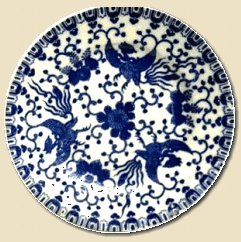 The symbol of the Phoenix has been used on objects in China, often in jade, for over 7,000 years, originally on good-luck totems, and then, from around 2,000 years ago to represent power sent from the heavens to the Empress. The symbol of the Phoenix has been used on objects in China, often in jade, for over 7,000 years, originally on good-luck totems, and then, from around 2,000 years ago to represent power sent from the heavens to the Empress.
A phoenix used to decorate a house showed loyalty and honesty in the people who lived there. The phoenix was believed to control the five tones of Chinese music and to represent the Confucian virtues of loyalty, honesty, decorum and justice.
Considering the importance of this mythical bird, it was inevitable that it would also be used to decorate tombs and graves. The right to wear jewellery showing the phoenix was reserved for important people, and showed that the wearer was a person of high moral values. <end Fenice quote>

LEARN MORE
Last Update = 27 Aug. 2011, added Phoenix Panel by Takamura
|
|